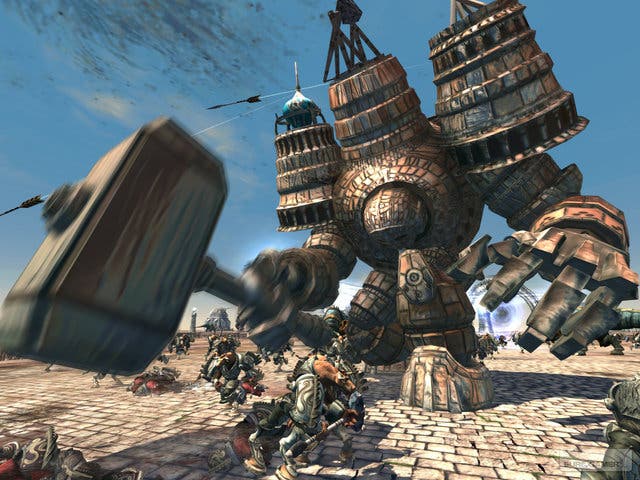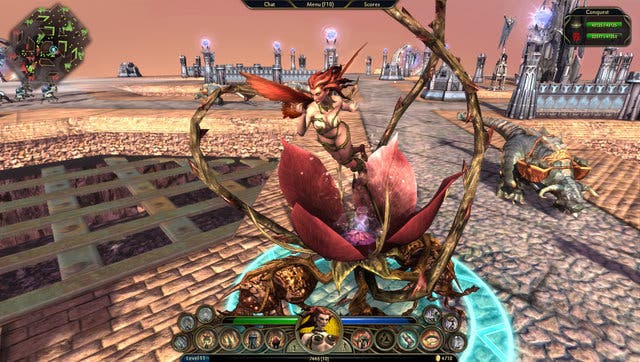Demigod
Divinely inspired, mortally wounded.
I've enjoyed many horrendous dreams through years of game-induced sleep-deprivation, but I've never had such a stupid nightmare as "trying to launch a multiplayer-only game which doesn't work in multiplayer". Yet that's what the Gas Powered Games boys, and their loyal fans, have had to put up with for the past month. If faith was ever panhandled, this beggars belief.
Admittedly, Stardock's developers didn't expect that targetting an exclusively hardcore market would lead to such ludicrous levels of piracy (85 per cent of copies were pirated, primarily because of an early release by American retailer GameStop), and that their legitimate players would be completely unable to find working multiplayer matches at launch as a result. But, as I understand it, it was their choice to force every copy, including the hundred thousand pirated copies, to be constantly connected to their own servers (which is a strange thing to do for a company ostensibly not interested in copy-protection) using inadequate net code, and it was this self-manufactured denial-of-service attack that was impressively "duh". If Multiwinia hadn't already won this year's Darwin(ian) Award for self-declared immolation, Demigod would have been the prime contender.
So, suffice to say, if Eurogamer had reviewed this at the launch of the digital download, it would have been beaten black and blue without even a cursory glance at its key elements. Now, however, with the European release, and Stardock CEO Brad Wardell declaring it "fixed", we've unleashed our analytical might.
To the basics! Demigod is a conversion of the Warcraft III mod Defense of the Ancients into a full game; that is, it's a rejigging of the standard RTS formula, whereby you're only in direct control of one unit, your demigod, and your other AI-controlled units are spawned in endless waves. Dotted around the map are flags that provide control of nearby items (like gold mines or healing points), and defensive towers, presumably to slow the pace of the game down. With up to four players on a side, you proceed to beat the living daylights out of the poor weak troops, whilst aiming to destroy the opposition and their citadel (there are four types of game-mode, but they mostly come down to CRUSH).

Of the eight godlings you can select, four are assassins - that is, direct damage-dealers - and four are generals, who can purchase a retinue of other troop types. Each has the delightful design of the original Warcraft III heroes, with a variety of colourful archetypes; among the assassins, the giant and iconic Rook is a building killer, the fragile Torchbearer can flip between damage-dealing and debuffing, Unclean Beast is speedy and does enormous damage over time, and Regulus is an angelic sniper. Over to the generals, Sedna is a tiger-mounted healer, Lord Erebus is an elusive vampire, Oak is a tough defensive necromancer, and Queen of Thorns does massive area damage. All of these four have special units that they can summon, as well as the standard three varieties of purchasable retinue.
Your demigods gain experience from killing each other and the endlessly fragile troops, and, as they level up, you can select new abilities from a skill tree that's very similar to World of Warcraft's. Indeed, levelling up can happen very quickly, especially if you avoid dying and focus on stomping plebs and buildings, letting you rapidly garner a range of neat powers. They all seem fairly balanced. The characters fit useful archetypes taken from RPGs everywhere, so exploring their skill trees and working out good builds, and good parties of demigods to slot them into, becomes the main source of interest and variety in the game.

The more customisable side of the upgrade system is buying magic items, reflecting those origins in Warcraft III, but it's a touch clunky. There are separate buildings at your base to visit to buy magic items and infrastructure/troop upgrades, which normally means a slow detour from the war. Moreover, the items are completely unbalanced - there are absolutely killer builds that can be made with certain characters (especially mana-hungry characters) and certain items, like teleport scrolls, are essential because of the distance you have to trudge; certain other items, like most of the helmets, are pretty much redundant. As your gold accretes at a set rate (boosted if you hold any mines), there's a very simple pay-off between upgrading your demigod and your army/infrastructure (which has its own tech tree).
Upgraded or not, few of the demigods live up to the promise of those original movies of the giant Rook; seeing those, we all imagined a pantheon of colossi, battling amidst teeming armies, yet we're disappointed. We've been left with this single giant, both slow and vulnerable, with the doomed air of his inspirational brethren from Shadow of the Colossus, and seven flaming dwarfs. Indeed, much of the promised content has been pared down.


